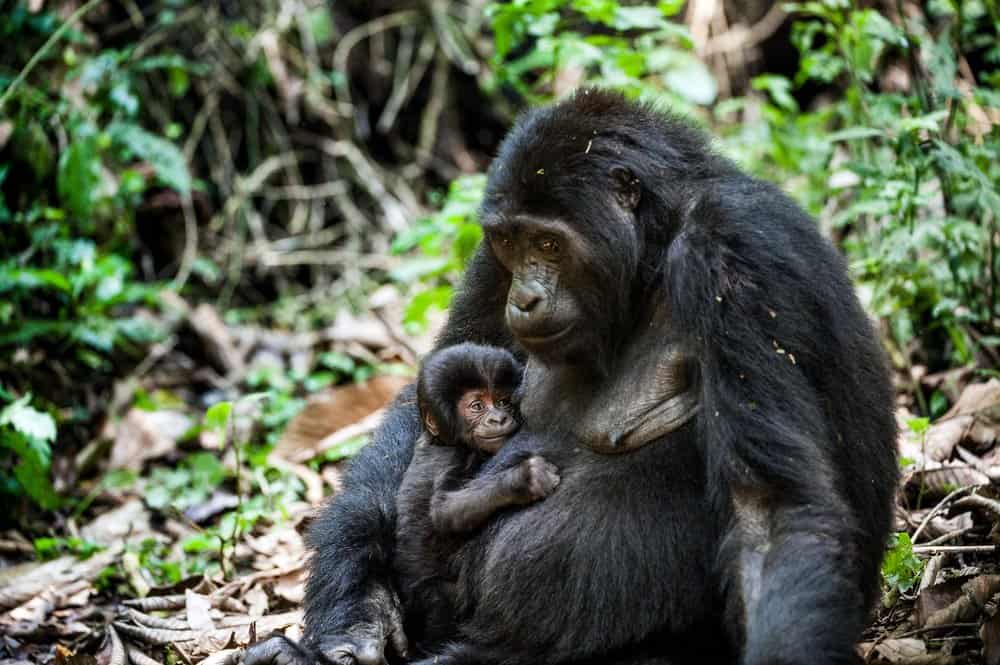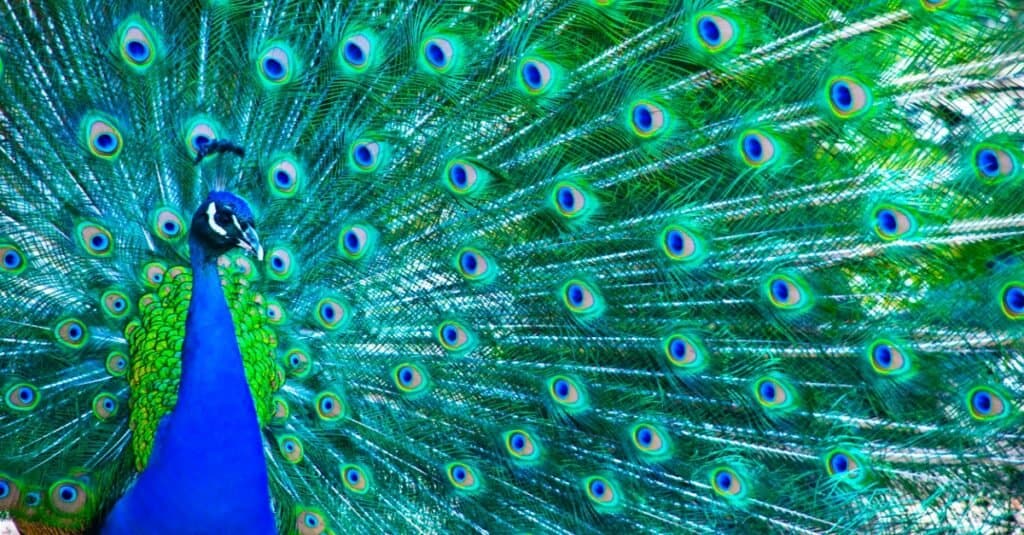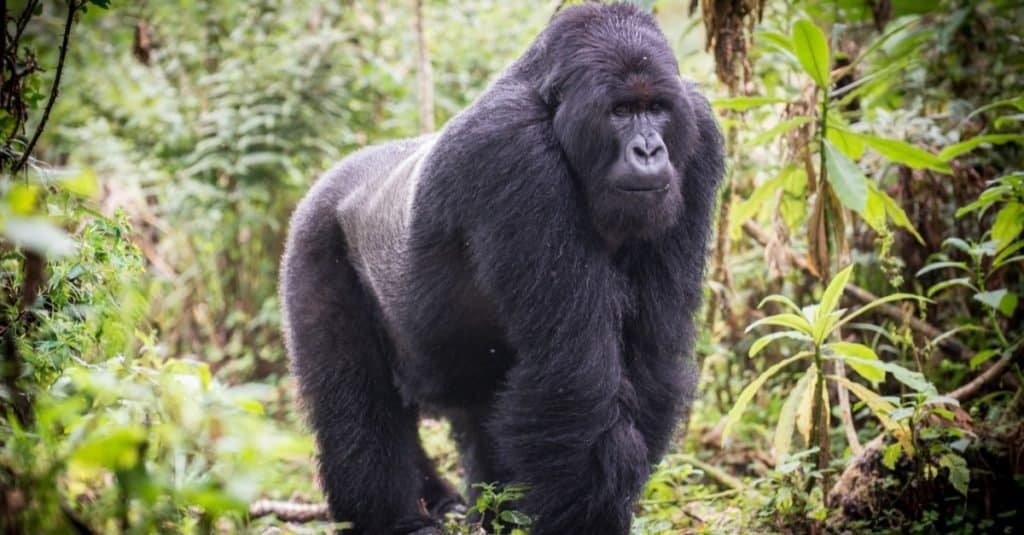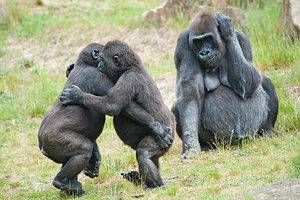When you are at the gym, a 20-pound dumbbell can seem pretty heavy. Now imagine 25 of those wrapped in fur running around the African wild! Silverback gorillas are huge, majestic animals and are the largest primate on Earth. Their size is amazing, but does it serve a purpose? From an evolutionary perspective, it requires a lot of energy and resources to grow to such a large size. A trait so costly would be selected against unless there was a substantial advantage. This article will investigate all aspects of a silverback gorilla’s weight and size. We’ll dive into why silverback gorilla weights exceed other primates by such a wide degree, their physical strength, and more!
What are Silverback Gorillas?

Silverback gorillas usually weigh between 300 and 500 pounds.
©iStock.com/dbar99
Gorillas are a primate closely related to humans. As such, they are great apes closely related to orangutans, chimpanzees, and bonobos. The term “silverback gorilla” usually refers to the dominant male gorillas of each troop because of the grey fur on their backs. Females of the same species do not have this distinct color pattern. There are two species of gorilla and four subspecies: western gorillas (western lowland gorillas and Cross River gorillas) and eastern gorillas (eastern lowland gorillas and mountain gorillas).
How Much do Silverback Gorillas Weigh?
Silverback gorillas weigh between 300 and 500 pounds while females are between 150 and 250 pounds. There are four gorilla subspecies all living in Africa across a patchy distribution interrupted by rivers and other geographical barriers. The largest gorilla subspecies is the eastern lowland gorilla. Their maximum weight is between 5 and 10% larger than other gorilla subspecies such as the mountain gorilla and western lowland gorilla.
Just how big can gorillas get? The largest gorilla ever recorded weighed 860 pounds and was an eastern lowland gorilla raised in the St. Louis Zoo. Gorillas are the largest primate on Earth!
Why are Gorillas so Big?
To understand why gorillas are so big, we need some background information. They are incredibly large because of many biological and ecological forces including their diet, finding a mate, and optimizing reproductive success.
Finding a Mate

A female mountain gorilla with an infant in a forest.
©Sergey Uryadnikov/Shutterstock.com
Gorillas exemplify sexual dimorphism. Sexual dimorphism is when males and females of the same species have very different morphologies or physical characteristics. A textbook example of sexual dimorphism is the peacock. Peacocks are known for their impressive tail feathers, but peahens have far less extravagant brown feathers. This exists throughout the animal kingdom. Other animals might differ between sexes with respect to coloration, plumage, canine tooth size, body size, and other interesting traits.

Peacocks have distinct, colorful plumage.
©iStock.com/AlexeyVis
Sexual dimorphism in gorillas is seen in their size difference- females weighing about half that of males. This occurs in different species, like gorillas, where there is competition amongst one sex for access to mates. In gorillas, and in our earlier example peacocks, males compete with other males for mating opportunities. For example, in peafowl, females are more likely to choose a mate with a flamboyant tail. One study examining mating success in Indian peafowl found that males with longer tails and with more frequent courtship displays had greater success finding mates.
Gorillas are amongst the most sexually dimorphic primate species. Larger, dominant males have greater mating success due in part to female preference and because of size advantages in direct confrontations with other males. Big male gorillas with big canine teeth are attractive as protectors and can fight for females more successfully. Therefore, larger males will have more offspring and will pass more genes on each generation than small subordinate males. Female gorillas do not have improved reproductive success if they are larger. A 2020 study of Rwandan mountain gorillas found that dominance rank among females has a positive correlation with reproductive success, but body size does not. Therefore, unlike males, there is no reproductive advantage to females being larger.
Why are Gorillas So Strong?

A mountain Gorilla (
Gorilla beringei beringei) walking in a forest.
©Jurgen Vogt/Shutterstock.com
A gorilla’s size is also associated with its strength. In gorilla troops, several females live with one male which provides protection. In return, the male has sole access to mating opportunities with the females. During physical confrontations, larger males have an advantage over smaller ones, so large males are better able to defend their troop or are better able to kill and supplant the dominant male of another troop. Large body size often evolves in species where aggressive physical conflict is prevalent because the larger individual will usually win the fight and live to reproduce.
Gorilla Body Size and Diet

An infant gorilla chewing on a stick.
©iStock.com/nantonov
The different gorilla species have varying diets, but all gorillas eat foliage such as leaves, branches, and shoots for food. Although eastern lowland gorillas occasionally eat insects, they are primarily herbivores. Like other herbivores, gorillas must eat large volumes of plant material to acquire adequate nutrients. Leaves have low nutrient densities and are not easy to digest. Increased body size allows herbivores to evolve gut structures that increase volume and retention time. They are then capable of extracting a higher amount of nutrients from low-energetic plant materials. Large body size therefore helps to accommodate the folivorous diet of gorillas! To read more about diet and body mass, click here.
Are Silverback Gorillas Friendly?

Gorillas that are familiar with humans, by becoming habituated, a process that can take years, are known to be friendly toward people who spend a long time with them.
©Philippe Clement/Shutterstock.com
Silverback gorillas are incredibly gentle apes with their families but are generally shy and reserved toward people. As the leader of the group, a silverback is always alert and aware of his surroundings, and should you get too close to either him or anyone in his family unit, he may become aggressive. These mammals will only attack when they perceive a threat or if they are surprised.
When around wild silverbacks, or gorillas in general, it is important to remain still and don’t make any sudden movements. It is also imperative to remember that no matter how much you would like to, or how appealing they may be, you should never touch them, or any other wild animal.
Although they may be wary of humans, they have also been known to come to their aid, and there have even been reports of gorillas stopping humans from walking into traps set by poachers. Additionally, gorillas that are familiar with humans, by becoming habituated, a process that can take years, are known to be friendly toward people who spend a long time with them, like animal behaviorists, guides, and researchers.
The photo featured at the top of this post is © Jeff W. Jarrett/Shutterstock.com
Thank you for reading! Have some feedback for us? Contact the AZ Animals editorial team.





